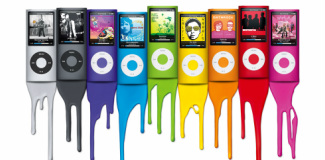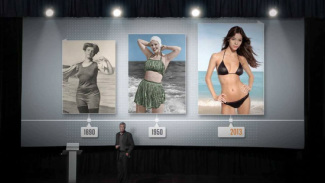 Apple attaches playful and whimsical meanings to its brand. Apple attaches playful and whimsical meanings to its brand.
Tags: capitalism, consumption/consumerism, corporations, culture, economic sociology, marketing/brands, marx/marxism, media, theory, apple, commodity fetishism, emotional branding, enchantment, 00 to 05 mins
Year: 1998; 2008; 2011 Length: 0:30 Access: YouTube (clip 1; clip 2; clip 3) Summary: Branding plays an increasingly important role in contemporary capitalism. Marketing industry experts describe a brand as a vision, a vocabulary, a story, and most importantly, a promise, which consumers experience through ads and products. One form of this is emotional branding, and in his book named for this approach, Marc Gobé argues that understanding emotional needs and desires, particularly the desire for emotional fulfillment, is imperative for corporate success today. Consumers unknowingly experience emotional branding throughout Apple’s wildly successful marketing. Based on a content analysis of more than 200 Apple TV ads (1984-2013), Gabriela Hybel and I found various expression of Apples’ emotional branding. They inspire feelings of happiness and excitement with playful and whimsical depictions of products and their users. This trend can be traced to the early days of the iMac, as seen in an ad (clip 1) from 1998. A 2008 iPod Nano ad (clip 2) combined playful imagery and song. In a more recent commercial (clip 3), actress and singer Zooey Deschanel, known for her “quirky” demeanor, performs a playful spin on the utility of Siri. Commercials like these — playful, whimsical, and backed by upbeat music — associate these same feelings with Apple products. They suggest that Apple products are connected to happiness, enjoyment, and a carefree approach to life. In George Ritzer’s words, they “enchant a disenchanted world.” They open up a happy, carefree, playful world for us, removed from the troubles of our lives and the implications of our consumer choices. Importantly, for Apple, the enchanting nature of these ads and the brand image cultivated by them act as a Marxian fetish: they obscure the social and economic relations, and the conditions of production that bring consumer goods to us. Now more than ever, Apple depends on the strength of its brand power to eclipse the mistreatment and exploitation of workers in its supply chain, and the injustice it has done to the American public by skirting the majority of its corporate taxes. For additional analyses of Apple’s commercials, see how they promote sentimentality, cool youthfulness, and the promise of social mobility. Note: this post was adapted from Dr. Cole’s original blog post at SocImages. Submitted By: Nicki Lisa Cole, PhD
2 Comments
 Ellen Degeneres spoofs Bic's new product: a pen for women. Ellen Degeneres spoofs Bic's new product: a pen for women. Tags: gender, inequality, marketing/brands, social construction, socialization, 00 to 05 mins Year: 2012 Length: 4:09 Access: YouTube Summary: This hilarious and poignant commentary by comedian Ellen DeGeneres is perfect when introducing—and critiquing—the social construction of gender in an Introduction to Sociology or Contemporary Social Problems course. The clip shows Degeneres comically critiquing Bic’s production of a pen "designed especially for women," made in pink and purple to “fit a woman’s hand.” There are many great lines in her shtick, including this one chocked full of sarcastic analysis: “I was reading the back of the package, well, I had a man read the back of the package to me, and it said it’s designed to fit a woman’s hand…What does that mean? So that when we’re taking down dictation from our bosses we’ll feel comfortable and we’ll forget we’re not getting paid as much?…Just think over the last 20 years, companies have made millions of dollars for pills that grow men’s hair and fix men’s sex lives, and now ladies have a pen. We’ve come a long way baby!” This clip offers multiple ways to facilitate a discussion about sexism and the social construction of gender. For example, Degeneres draws attention to gender and socialized color preferences, the higher cost of women’s products and services compared to men’s, occupational sex segregation and wage inequality, gender stereotypes (e.g., grocery shopping, cooking, mood swings, etc.), and gendered investments in research for “life improvements” (e.g., products for sexual satisfaction and hair growth). One way to initiate conversation is to ask students: What makes Degeneres's characterization of these subjects humorous? Submitted By: Beverly M. Pratt  Can men control their reactions to attractive women? Can men control their reactions to attractive women? Tags: bodies, gender, marketing/brands, media, sex/sexuality, commercial, rape culture, 00 to 05 mins Year: 2013 Length: 0:32 Access: YouTube Summary: Beyond simply objectifying women, this commercial for the Axe Chill Collection presumes a relationship between female attractiveness and men's uncontrollable responses. The message is clear: because girls are hot, guys lose their "cool" and, therefore, are unable to control themselves. The ad suggests that their product "helps guys keep their cool before it's too late" but what is implied here? Before it's too late for what? While the commercial depicts men having accidents (e.g. crashing into a car), the obvious sexualization seems to imply that men would also act on their sexual impulses in an inappropriate manner. Again, the message is clear: men are not to blame for these reactions; instead the blame is on women and their "hotness." This attribution of blame, along with the overall sexual objectification of women, are key dimensions of rape culture, which encompasses a set of values and beliefs that legitimate male sexual aggression and rape. Viewers may reflect on the degree to which such messages, also found in music videos and throughout our culture, shape men's actions and attitudes about sex and gender. Submitted By: Anonymous  Film exposes big drug companies' dangerous marketing tactics. Film exposes big drug companies' dangerous marketing tactics.
Tags: capitalism, commodification, consumption/consumerism, corporations, health/medicine, marketing/brands, pharmaceutical industry, prescription drugs, 21 to 60 mins
Year: 2007 Length: 49:23 Access: YouTube (trailer) Summary: The filmmakers of this documentary argue that "missing in the health care debate is how drug companies are putting your and your family's safety at risk in order to make more money." Money Talks: Profits Before Patient Safety exposes the questionable tactics that big drug companies use to make record profits by playing with the safety of our health care. Using misleading advertising, attractive "drug reps" who wine and dine doctors, and other unethical practices, the drug industry makes billions of dollars every year selling us unsafe, unnecessary, and overpriced drugs. The film gives an in-depth, academic perspective on the questionable marketing tactics of the pharmaceutical industry, and features the commentary of investigative journalists, former pharmaceutical sales representatives, and medical professionals including Dr. John Abramson, author of Overdo$ed America, and Alex Sugerman-Brozan, director of the Prescription Access Litigation Project. Other notable interviewees include Dr. Bob Goodman of Columbia University, founder of the "No Free Lunch" program, and Dr. Jerome Hoffman of UCLA Medical School. Money Talks: Profits Before Patient Safety was chosen by the American Library Association as one of the most notable films for adults in 2008. Submitted By: Holly Mosher  Rapper Macklemore surrounded by Nike products and symbols Rapper Macklemore surrounded by Nike products and symbols
Tags: art/music, capitalism, commodification, consumption/consumerism, marketing/brands, marx/marxism, theory, baudrillard, commodity fetishism, exchange-value, labor, lacan, surplus value, signified, signifier, symbols, use-value, 00 to 05 mins
Year: 2011 Length: 5:33 Access: YouTube Summary: Seattle rapper Macklemore's music video for his thought-provoking song “Wings” is an excellent way to introduce students to Marx’s theory of commodity fetishism. Commodity fetishism is the process of ascribing magic “phantom-like” qualities to an object, whereby the human labour required to make that object is lost once the object is associated with a monetary value for exchange. Under capitalism, once the object emerges as a commodity that has been assigned a monetary value for equivalent universal exchange, it is fetishized, meaning that consumers come to believe that the object has intrinsic value in and of itself. The object’s value appears to come from the commodity, rather than the human labor that produced it. In “Wings,” Macklemore associates this process of commodity fetishism with Nike Air Max athletic shoes, explaining his belief as a child that the shoes would make him into a superstar athlete like Michael Jordan. The value of Nike shoes is displaced from the labour time that went into creating them, and instead is infused with an intrinsic value that comes into being through celebrity endorsement or symbols such as the iconic Nike “Swoosh.” “Wings” becomes a statement on how market capitalism seduces us into purchasing products that promise to make our lives better. Macklemore comes to this realization through the song’s narrative, exclaiming, “Nike tricked us all,” before finally realizing as the song comes to an end that “it’s just another pair of shoes.” Through tracks like “Wings,” Macklemore explores the darker side of consumption, urging listeners to critically rethink the messages imposed on us in capitalist societies that make us feel the need to constantly consume. This video can also be used to teach and distinguish among Marx's notions of use-value and exchange-value, as well as his concept of surplus-value, which is the surplus or profit earned by the capitalist, above and beyond the use-value (labour power) required to produce the object. Viewers may be urged to identify the use-, exchange-, and surplus-values of the Nike shoe in the video. How is value made? Why do we pay $180 for a pair of Nike shoes, but only $20 for a pair of Sketcher shoes? In addition, this video bolsters discussion about the power of symbols and signification (and Baudrillard’s notion of sign-value) in creating cultural meaning embodied in a commodity sign (e.g., the Swoosh on the Nike shoe, or the Apple symbol on an iPhone). Instructors can ask students to name other symbols in popular culture and what they mean to them. Drawing upon Jacques Lacan’s idea of the signifier and signified, instructors can expand the discussion of symbols by asking students to discuss the role of brand symbols in their life. Have they become a part of their identity? Their culture? Their daily lives? In the end, Macklemore speaks to this point: his Nikes are “so much more than just a pair of shoes.” They are “what I am… the source of my youth… the dream that they sold to you.” For another post on The Sociological Cinema that uses Macklemore's music videos to teach sociological concepts, click here. Submitted By: Patricia Louie  Tags: children/youth, gender, marketing/brands, media, sex/sexuality, gender binary, 00 to 05 mins Year: 2010 Length: 0:29 Access: YouTube Summary: This diaper advertisement from Australia is an excellent illustration of how sex and gender are treated as the same thing. Sociologists have long drawn attention to the difference between sex and gender, where sex refers to biological or physiological differences such as chromosomes, hormonal make-up, and sex organs (internal and external) and gender refers to characteristics that a society or culture define as masculine or feminine. In this ad, diapers targeting physiological differences are marketed with images of gender differences (and stereotypical ones at that). I find this advertisement useful for getting students to discuss gender binaries and the difference between sex and gender. Submitted By: Michelle Sandhoff  Advertisement for the Fiat 500 Abarth Advertisement for the Fiat 500 Abarth
Tags: bodies, consumption/consumerism, gender, marketing/brands, media, sex/sexuality, representation, sexual
objectification, 00 to 05 mins Year: 2011 Length: 1:00 Access: YouTube Summary: In this television advertisement for the Fiat 500 Abarth, a man has a passionate encounter with a seductive Italian woman, who turns out to be a car. Literally. I use this clip to teach the concept of sexual objectification. First, I have my students read Caroline Heldman's essay on how to identify sexual objectification in media images. In this essay, Heldman defines the term as follows: "If objectification is the process of representing or treating a person like an object, then sexual objectification is the process of representing or treating a person like a sex object, one that serves another’s sexual pleasure." I then screen this Fiat commercial in class and have students deconstruct it, using Heldman's 7-item Sex Object Test (SOT) as a resource to guide our analysis. This approach gives us a lot to talk about, including the way the woman in the advertisement stands in for an object, the interchangeability of sex objects (she only speaks Italian and appears to be incomprehensible to the fantasizer), the way in which her body is literally branded with the Abarth logo, and the ejaculatory imagery. Instructors can go on to discuss the harm associated with sexual objectification, which Heldman addresses in Part 2 of her series on sexual objectification, and which is also discussed in the films Killing Us Softly and Miss Representation. Submitted By: Michelle Sandhoff  Tags: children/youth, gender, marketing/brands, organizations/occupations/work, science/technology, adulthood socialization, 00 to 05 mins Year: 2012 Length: 0:52 Access: YouTube Summary: This video was published by the European Commission for a campaign designed to attract more women to a career in science. The commission said that the video had to "speak their language to get their attention" and that it was intended to be "fun, catchy" and strike a chord with young people. The original video was taken down after it received so many negative comments. This tactic, however, of flashing a few pink gimmicks in an effort to get girls interested in (or purchase products related to) traditionally masculine activities is nothing new; instructors can point to numerous examples including the marketing of video games and computer technology (both the hardware and software). This clip would be useful for illustrating to students the ways in which gender socialization, often discussed in the classroom in the context of pink and blue toys for children, carries into adulthood in very obvious ways (e.g., Dell's short-lived Della computers). However, instructors might ask students to name some less obvious ways that gender socialization in adulthood takes place. Further, instructors might take a counterposition in an effort to spark classroom discussion, for example, posing the question: What's the harm of using a little pink and slick sexuality to get women involved in science? If successful, wouldn't this be a feminist victory in that more women would move into an occupational field currently dominated by men? Submitted By: Anonymous  Kyle and Stan attempt to destroy the heart of Wall-Mart Kyle and Stan attempt to destroy the heart of Wall-Mart
Tags: capitalism, commodification, consumption/consumerism, corporations, economic sociology, marketing/brands, marx/marxism, political economy, theory, culture industry, false needs, max horkheimer, theodor adorno, wal-mart, 00 to 05 mins
Year: 2004 Length: 3:48 Access: South Park Studios Summary: In this South Park clip, Kyle and Stan enter the local Wall-Mart in an attempt to ruin the business because the people of South Park have been negatively affected by its recent opening in their town. Having been led to believe that destroying the “heart” will destroy the business, the boys search the store for the “heart” of Wal-Mart . While Randy (Stan's father) is walking through the store with the boys, he is distracted by the fact that Wal-Mart continues to lower their prices. Everywhere he looks there are items that he does not need, but he continues to buy them because of the low prices. In this way, Wal-Mart is creating “false-needs,” which are created and fulfilled by capitalism, and exert power over Randy. When the boys meet the man that calls himself “Wal-Mart,” he claims that he can take any “form” that he chooses. He then switches clothes, thereby acquiring different forms through consumer goods, and asks the boys which “form” they prefer. When the boys find the “heart,” they are surprised to see that it is a mirror; i.e. the “heart” of Wal-Mart is the consumer. The man adds that his “forms” can be Wal-Mart, K-Mart, and Target, but that he represents one single entity, “desire.” This desire is the power that is exerted over people by major corporations. While the clip seems to suggest that Wal-Mart is simply fulfilling the desires of the consumer, viewers may consider how such desire and the low prices of Wal-Mart are produced more broadly. Through advertising and Wal-Mart's artificially low prices (e.g. by exploiting cheap labor), these desires are produced like a commodity in a factory and are a fundamental mechanism for capitalist control over people. By suggesting that the "heart of Wal-Mart" is the consumer, does it offer hope in us being able to change the corporate giant or does it unfairly place blame on individuals for a bigger structural issue? Submitted By: Sean Kelley and Ian Hammer  Tags: gender, inequality, marketing/brands, marriage/family, media, social construction, commercial, culture, domestic labor, gender socialization, motherhood, stereotypes, unpaid work, women's work, 00 to 05 mins Year: 2012 Length: 2:02 Access: YouTube Summary: In this advertisement for P&G (Proctor and Gamble) products the claim is made that a mother's job is the hardest job in the world, but also the best job. The short clip constructs a very narrow representation of motherhood throughout the world as it takes viewers through a dramatization of several Olympic athlete's upbringing. In each case, and in the various cultures, the mother is responsible for things such as: waking the child, getting the child off to school, feeding and clothing the child, dressing injuries, and taking them to extra-curricular (sporting) activities. Men are excluded from any form of domestic labor, and they are only present for the viewing of the sporting events. Throughout the dramatization, the assumption is that these are the tasks that mothers perform, and if the job is done well the child will reach success. The last few seconds of the clip show the mothers reaping the reward of their efforts while celebrating their grown child's Olympic success. This clip could would fit nicely with discussions of the social construction of familial/gender roles. This depiction is a narrow and stereotypical construction of a woman's role in the family. The media is a major socializing force in society, and they have the power to create and uphold these ideal types through the images and stories they produce. Viewing of this video could also lead to an in-depth discussion of gender inequality within the family with regard to unpaid, domestic labor. Why are women the only ones performing these duties? Do men contribute to the birth of an Olympic athlete (maybe they're saving this for Father's Day)? Furthermore, it could result in a discussion about the appropriation of holidays and other cultures to market and sell products. Submitted By: Tracy DeHaan, University of Oregon |
Tags
All
.
Got any videos?
Are you finding useful videos for your classes? Do you have good videos you use in your own classes? Please consider submitting your videos here and helping us build our database!
|
 RSS Feed
RSS Feed
